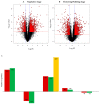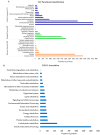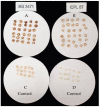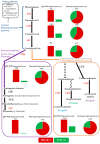Comparative TMT Proteomic Analysis Unveils Unique Insights into Helicoverpa armigera (Hübner) Resistance in Cajanus scarabaeoides (L.) Thouars
- PMID: 34073052
- PMCID: PMC8198728
- DOI: 10.3390/ijms22115941
Comparative TMT Proteomic Analysis Unveils Unique Insights into Helicoverpa armigera (Hübner) Resistance in Cajanus scarabaeoides (L.) Thouars
Abstract
Pigeonpea [Cajanus cajan (L.) Millspaugh] is an economically important legume playing a crucial role in the semi-arid tropics. Pigeonpea is susceptible to Helicoverpa armigera (Hübner), which causes devastating yield losses. This pest is developing resistance to many commercially available insecticides. Therefore, crop wild relatives of pigeonpea, are being considered as potential sources of genes to expand the genetic base of cultivated pigeonpea to improve traits such as host plant resistance to pests and pathogens. Quantitative proteomic analysis was conducted using the tandem mass tag platform to identify differentially abundant proteins between IBS 3471 and ICPL 87 tolerant accession and susceptible variety to H. armigera, respectively. Leaf proteome were analysed at the vegetative and flowering/podding growth stages. H. armigera tolerance in IBS 3471 appeared to be related to enhanced defence responses, such as changes in secondary metabolite precursors, antioxidants, and the phenylpropanoid pathway. The development of larvae fed on an artificial diet with IBS 3471 lyophilised leaves showed similar inhibition with those fed on an artificial diet with quercetin concentrations with 32 mg/25 g of artificial diet. DAB staining (3,3'-diaminobenzidine) revealed a rapid accumulation of reactive oxygen species in IBS 3471. We conclude that IBS 3471 is an ideal candidate for improving the genetic base of cultivated pigeonpea, including traits for host plant resistance.
Keywords: Cajanus cajan; IBS 3471; ICPL 87; TMT; feeding bioassays; phenypropanoid pathway; pigeonpea; quercetin.
Conflict of interest statement
The authors declare no conflict of interest.
Figures








Similar articles
-
Helicoverpa armigera preference and performance on three cultivars of short-duration pigeonpea (Cajanus cajan): the importance of whole plant assays.Pest Manag Sci. 2023 Feb;79(2):627-637. doi: 10.1002/ps.7230. Epub 2022 Oct 27. Pest Manag Sci. 2023. PMID: 36222835 Free PMC article.
-
Comparative Analysis Delineates the Transcriptional Resistance Mechanisms for Pod Borer Resistance in the Pigeonpea Wild Relative Cajanus scarabaeoides (L.) Thouars.Int J Mol Sci. 2020 Dec 30;22(1):309. doi: 10.3390/ijms22010309. Int J Mol Sci. 2020. PMID: 33396747 Free PMC article.
-
Pigeonpea genotypes influence parasitization preference and survival and development of the Helicoverpa armigera larval parasitoid, Campoletis chlorideae.Springerplus. 2014 Jul 28;3:378. doi: 10.1186/2193-1801-3-378. eCollection 2014. Springerplus. 2014. PMID: 25110629 Free PMC article.
-
Sterility Mosaic Disease of Pigeonpea (Cajanus cajan (L.) Huth): Current Status, Disease Management Strategies, and Future Prospects.Plants (Basel). 2024 Aug 2;13(15):2146. doi: 10.3390/plants13152146. Plants (Basel). 2024. PMID: 39124264 Free PMC article. Review.
-
Advances in genetics and molecular breeding of three legume crops of semi-arid tropics using next-generation sequencing and high-throughput genotyping technologies.J Biosci. 2012 Nov;37(5):811-20. doi: 10.1007/s12038-012-9228-0. J Biosci. 2012. PMID: 23107917 Review.
Cited by
-
Plant Cell and Organism Development 2.0.Int J Mol Sci. 2022 Feb 8;23(3):1885. doi: 10.3390/ijms23031885. Int J Mol Sci. 2022. PMID: 35163807 Free PMC article.
-
Deciphering of Pod Borer [Helicoverpa armigera (Hübner)] Resistance in Cajanus platycarpus (Benth.) Offers Novel Insights on the Reprogramming and Role of Flavonoid Biosynthesis Pathway.Toxins (Basel). 2022 Jul 2;14(7):455. doi: 10.3390/toxins14070455. Toxins (Basel). 2022. PMID: 35878193 Free PMC article.
References
-
- Hillocks R.J., Minja E., Mwaga A., Nahdy M.S., Subrahmanyam P. Diseases and pests of pigeonpea in eastern Africa: A review. Int. J. Pest Manag. 2000;46:7–18. doi: 10.1080/096708700227534. - DOI
-
- FAOSTAT. [(accessed on 30 September 2020)];2018 Available online: http://www.fao.org/faostat/en/
-
- Choudhary A.K., Raje R.S., Datta S., Sultana R., Ontagodi T. Conventional and Molecular Approaches towards Genetic Improvement in Pigeonpea for Insects Resistance. Am. J. Plant Sci. 2013;4:372–385. doi: 10.4236/ajps.2013.42A049. - DOI
-
- Kriticos D.J., Ota N., Hutchison W.D., Beddow J., Walsh T., Tay W.T., Borchert D.M., Paula-Moraes S.V., Czepak C., Zalucki M.P. Correction: The Potential Distribution of Invading Helicoverpa armigera in North America: Is It Just a Matter of Time? PLoS ONE. 2015;10:e0133224. doi: 10.1371/journal.pone.0133224. - DOI - PMC - PubMed
-
- Tossou E., Tepa-Yotto G., Kpindou O.K.D., Sandeu R., Datinon B., Zeukeng F., Akoton R., Tchigossou G.M., Djègbè I., Vontas J., et al. Susceptibility Profiles of Helicoverpa armigera (Hübner) (Lepidoptera: Noctuidae) to Deltamethrin Reveal a Contrast between the Northern and the Southern Benin. Int. J. Environ. Res. Public Health. 2019;16:1882. doi: 10.3390/ijerph16111882. - DOI - PMC - PubMed
MeSH terms
Substances
Grants and funding
LinkOut - more resources
Full Text Sources
Other Literature Sources

